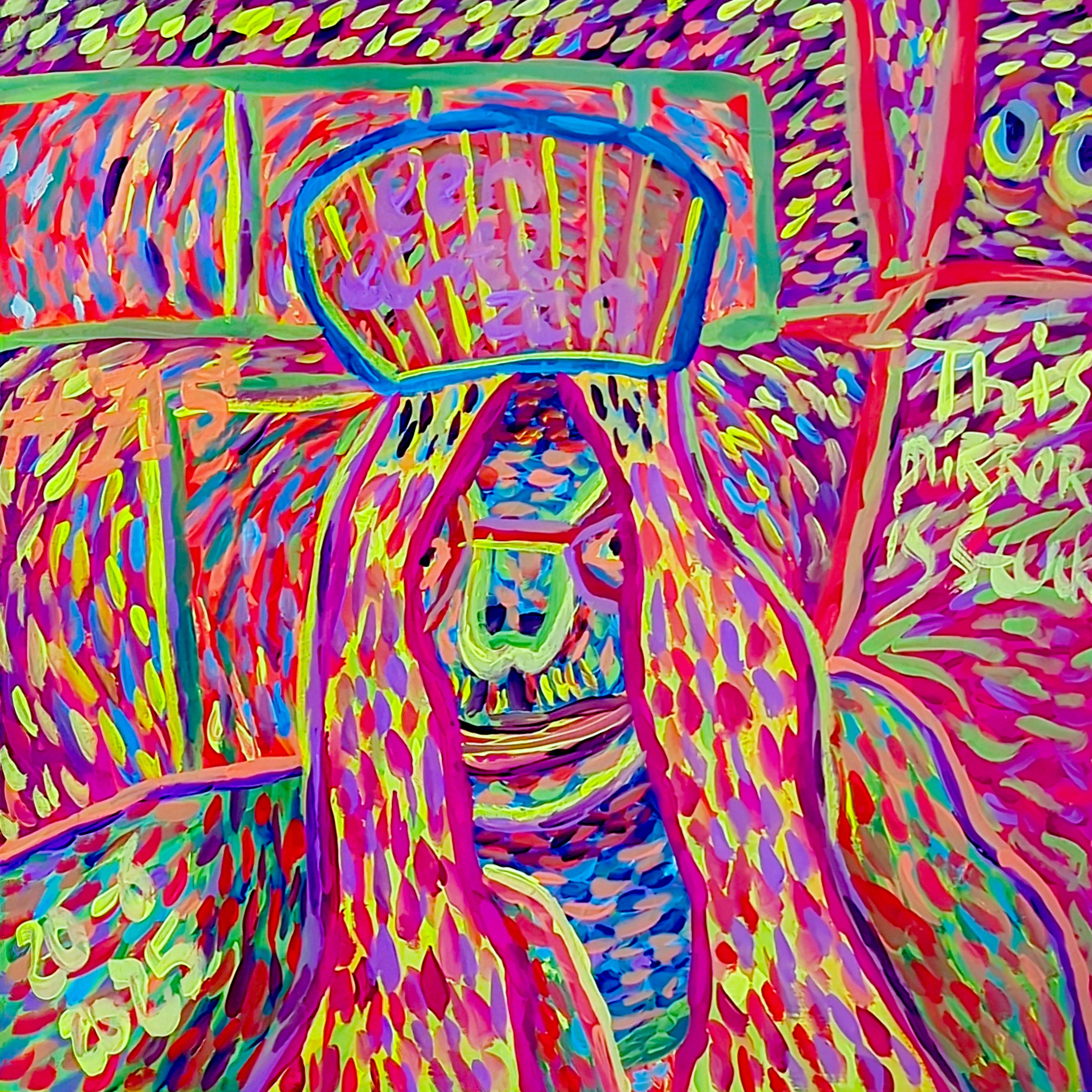
Contemporary Art for Your Living Room: An Artist's Ultimate Guide to Finding & Displaying Your Vibe
Ready to transform your living room with contemporary art? This artist's guide covers finding your style, where to buy, budgeting, displaying, caring for art, plus tips on commissioning and building your collection.
Contemporary Art for Your Living Room: Finding Your Vibe
Okay, let's talk about the living room. It's the heart of the home for many of us, right? Where we collapse after a long day, binge-watch questionable TV, argue about whose turn it is to do the dishes, and maybe, just maybe, have a moment of quiet reflection. And what's on the walls? Often, it's... well, whatever ended up there. Maybe a print you bought in college (still?), a family photo that's slightly askew, or just... blank space. Or perhaps a patch of slightly peeling paint you've been meaning to address for months. But what if it could be more? What if it could be a space that truly reflects you, that sparks conversation, or simply brings you a quiet moment of joy every time you look at it? What if it felt like a curated extension of your inner world?
That's where contemporary art comes in. And before you picture sterile white galleries and price tags that make your eyes water, let me tell you, it's not always like that. It's about finding something that resonates, something that feels alive and relevant to you, right here, right now. It's about bringing a piece of the vibrant, complex world of art into your most personal space.
What Exactly Is "Contemporary Art" Anyway?
Good question! It's one I get asked a lot, and honestly, the lines can be a little blurry. Generally, when we talk about contemporary art, we mean art created roughly from the 1970s or 80s to the present day. Why the 70s/80s? Well, it's often seen as a period when artists really started pushing back against the established norms of Modernism, embracing new technologies, materials, and a wider range of subjects, often reflecting the rapidly changing social and political landscape. It's incredibly diverse, experimental, and often reflects the world we live in now – with all its complexities, joys, and anxieties. Think beyond just paintings; it can be sculpture, photography, video, installation, performance art, and even digital creations. It often incorporates new materials, explores social or political themes, or challenges traditional notions of what art can be. The rise of the internet and social media, for instance, has profoundly impacted how contemporary art is made, shared, and even experienced, blurring geographical boundaries and giving artists new platforms. This has also made contemporary art more accessible to home buyers than ever before, with a wider range of price points and ways to discover artists. If you want to dive deeper into the timeline and meaning, I've explored that before in articles like When Did Contemporary Art Start? The (Gloriously Fuzzy) Artist's Guide and Contemporary Art Meaning: An Engaging Guide to Understanding.
It's art that's happening now, created by artists who are navigating the same world you are. That's why it can feel so relevant and exciting.
Within the vast umbrella of contemporary art, you'll find countless styles and approaches. For your living room, you might encounter Abstract Expressionism with its raw emotion and gestural marks, the bold imagery of Pop Art, the clean lines of Minimalism, thought-provoking Conceptual Art, dynamic Street Art, or intricate Mixed Media pieces. Contemporary art also embraces mediums like textile art, ceramics, and digital art displayed on screens or printed on materials like metal or acrylic. Each brings a different energy and texture to a space. An abstract piece might energize a corner, while a figurative work could add a sense of narrative. Understanding these different types of artwork can help you narrow down what might resonate with your personal space and taste. There's also an increasing blurring of lines between what was traditionally considered 'fine art' and other creative fields like design, craft, and digital media, making the contemporary art landscape even richer and more varied for your home. Think of the bold, often political work of Ai Weiwei, the visceral paintings of Adrian Ghenie, or the conceptual installations of Rudolf Stingel – these are just a few examples of the diverse voices working today.
For example, consider a piece like Antony Gormley's wire sculptures. These aren't traditional paintings or marble busts; they're often made from industrial materials and explore themes of the human form and space in a very contemporary way. Or think about the vibrant, often politically charged street art you see in cities – that's contemporary art reflecting urban life and social commentary. It's this willingness to experiment with form, material, and subject that defines the period.

Why Your Living Room Needs Contemporary Art (Beyond Just Filling Space)
Look, you could hang anything on your walls. A nice landscape print, a mirror, even just paint it a bold color. Or just stare at that slightly peeling patch of paint I mentioned earlier. But contemporary art offers something different. It's a window into another person's perspective, a conversation starter, a daily dose of inspiration, or even just a splash of color that makes you smile. It can also be a powerful way to reflect your personal values and identity, making your living room feel truly authentic to you. Beyond that, art has a unique ability to make a space feel finished. It's like the final piece of the puzzle that pulls together all the elements of your decor, adding depth and intention. And let's not forget, buying art, especially from emerging artists or directly from creators like myself, is a fantastic way to support the arts and bring a piece of someone's creative journey into your home.
For me, as an artist, my living space is an extension of my studio in a way. It's where I live with the ideas, where I see how different pieces interact, and where the art isn't just decoration, but part of the furniture, part of the feeling of the room. It's personal. I remember one particularly grey winter, I hung a large abstract piece bursting with warm oranges and yellows in my living room. It wasn't just a painting; it felt like a portable sun, genuinely lifting my mood every time I walked past it. A large, vibrant abstract piece, for instance, can instantly energize a neutral room and become a focal point that draws the eye and lifts the mood. A more subtle, textured piece might add depth and a sense of calm to a reading nook. A thought-provoking figurative piece or a striking photograph can spark fascinating discussions when guests visit. It's about creating a space that feels authentic and alive, just like the art itself. It can even reflect your aspirations or dreams, serving as a visual reminder of where you're headed or what you value most.
It's not about being 'trendy' or 'collecting' in a stuffy way. It's about bringing something into your most personal space that genuinely moves you. And that's what I think it should be for you too.
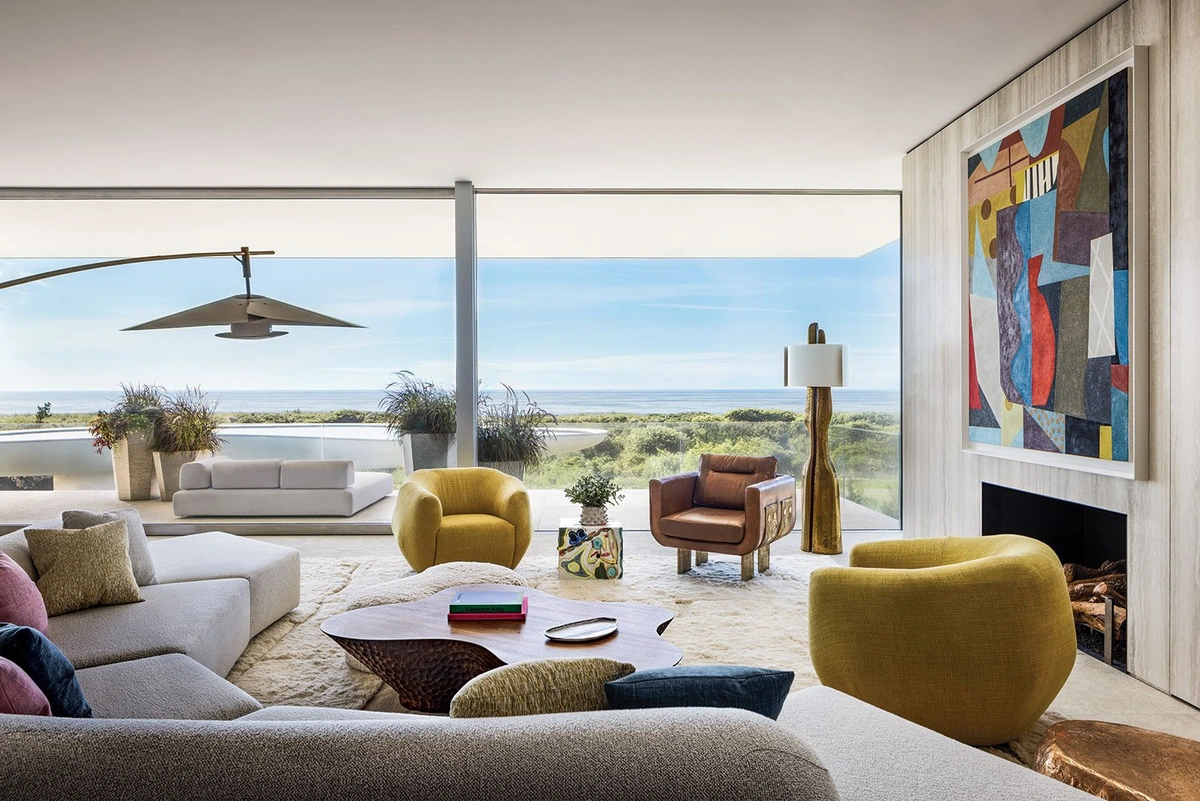
Finding Your Piece: It's Personal
This is the fun part, and also potentially the most daunting. How do you choose? There's no single right answer, but here's my personal approach – less about rules, more about feeling. When you're ready to find that perfect piece, keep these key considerations in mind:
Trust Your Gut (Seriously)
Forget what you think you should like or what's 'popular'. Walk into a gallery (or scroll online) and see what stops you. What makes you pause? What makes you feel something, anything? Maybe it's the color, the subject, the texture, or just a weird, unexplainable pull. That's your gut talking. Listen to it. I remember once being drawn to a piece that was just... weird. Like, really weird. It didn't fit my usual taste at all, but there was something about the energy, the raw honesty of it. I ended up buying it, and it's still one of my favorites, a constant reminder to trust that initial, illogical connection. On the flip side, I once bought a piece because I felt I should like it – it was by a well-known artist, the 'right' style – but it never truly resonated. It just sat there, looking nice but feeling empty. Trusting your gut, even if it leads you to something unexpected, is key. I've written about How to Define Your Personal Art Style and Taste: A Discovery Guide before, and it really boils down to paying attention to what genuinely resonates.
Size Matters (But Maybe Not How You Think)
Yes, a huge statement piece can be amazing in a large living room. But a small, intricate piece can be just as impactful in a cozy corner or as part of a gallery wall. Don't feel pressured to go big if a smaller piece captures your heart. Think about the wall space you have, the furniture around it, and the overall scale of the room. A piece that's too small can get lost, but one that's too big can overwhelm. As a general rule of thumb, when hanging art above furniture like a sofa or console table, aim for the bottom edge of the frame to be about 6-8 inches (15-20 cm) above the top of the furniture. But also consider the vertical space – if you have high ceilings, you might hang the art slightly higher to fill the space better, or use vertical pieces to draw the eye upwards. Think about how the art relates not just to the furniture below, but to the entire wall and the room's proportions, including doorways and windows. Also, consider the visual weight of the piece – a dark, dense painting might feel heavier than a light, airy one of the same size. It's a balance, and sometimes you just have to eyeball it... and maybe measure twice, unlike that one time I bought a canvas that was definitely bigger in person than it looked online. Oops.
Color and Mood
Color is powerful. It can energize, calm, or intrigue. Think about the existing colors in your living room – your sofa, walls, rug, plants. Do you want the art to complement these colors, or provide a bold contrast? Do you want the room to feel vibrant and lively, or serene and peaceful? The colors in the art will heavily influence the mood. For me, there's something about the combination of deep blues and warm oranges that just feels right – it's both calming and dynamic. Generally, warm palettes (reds, oranges, yellows) tend to create a feeling of energy, warmth, and intimacy, while cool palettes (blues, greens, purples) often evoke calmness, serenity, and spaciousness. Understanding these basic psychological effects of color can help guide your choice. Also, consider the type of lighting in the room – warm LED bulbs will make reds and yellows pop, while cooler daylight bulbs might enhance blues and greens. Art can also be a fantastic way to introduce a new accent color into a room's palette. I'm obsessed with how artists use color, and you can read more about it in The Secret Language of Color: An Artist's Guide to How Pigment Speaks or specifically about Choosing Art Based on Room Color: An Artist's Guide to Harmony & Contrast.
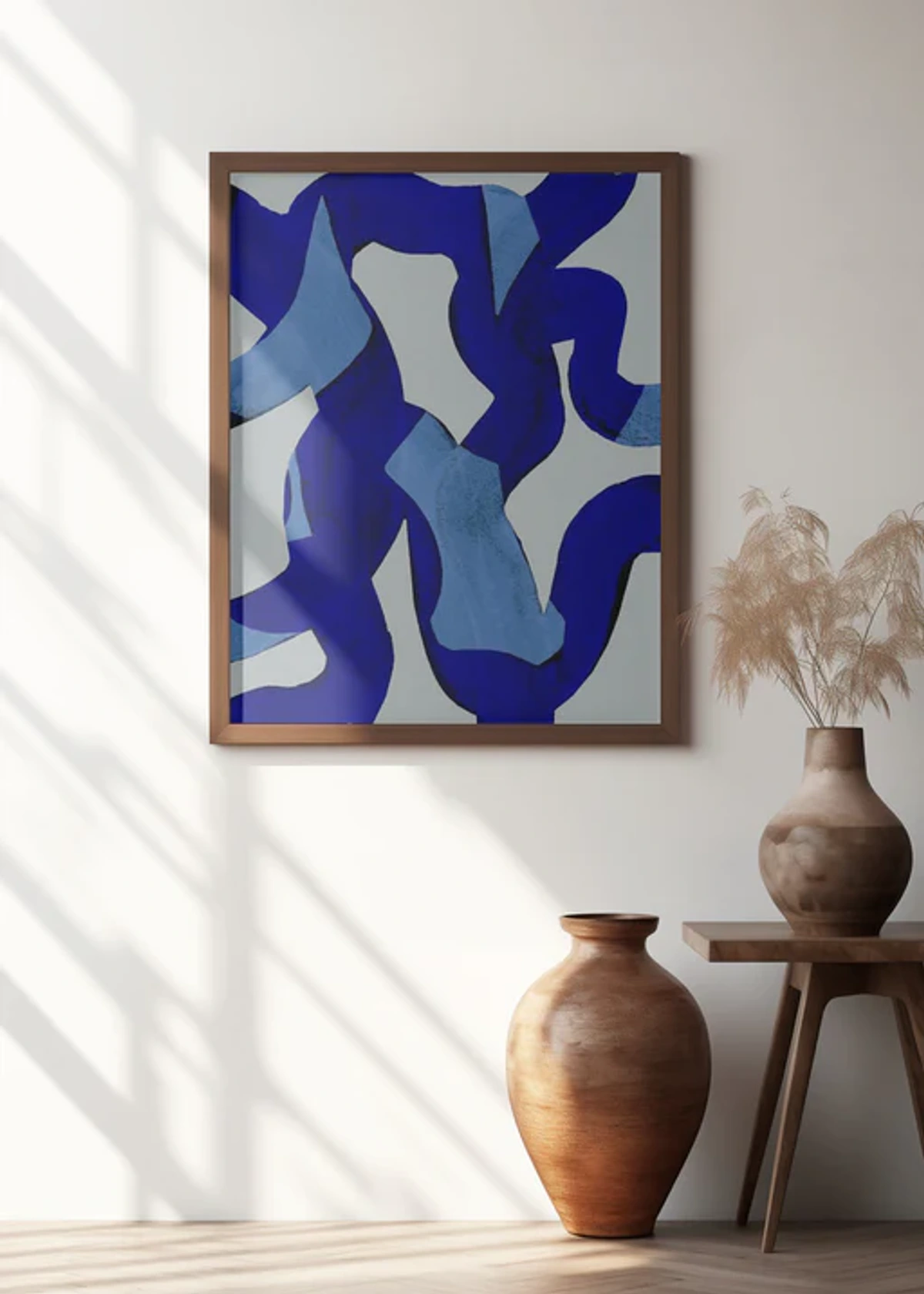
Subject Matter & Emotion
What does the art depict? Is it abstract? Figurative? A landscape? Does it evoke a specific feeling? Contemporary art often tackles complex themes or presents familiar subjects in new ways. Think about what kind of energy or conversation you want the piece to bring into your space. Sometimes, art about love or nature feels right. Other times, something more challenging or introspective might resonate, like art about anxiety or loss. Choosing art with specific subject matter can also be a wonderful way to subtly reflect your personal interests, hobbies, or core values in your living room – whether it's a piece inspired by music, travel, or a particular cause you care about. It's okay to choose something purely because you love the way it looks, but often, the pieces we connect with most deeply are those that stir something within us. A calming landscape might be perfect for a reading nook, while a dynamic abstract could work behind the main seating area. I recently acquired a small, textured piece that subtly depicts a forest scene, and just having it in my line of sight while I work brings a surprising sense of calm and connection to the outdoors, even when I'm stuck inside.
Considering the Light
This is a practical one that's easy to overlook. How does the light hit the wall where you plan to hang the art? Natural light changes throughout the day, and artificial light has its own qualities. A piece with subtle textures might get lost in a dimly lit corner, while a highly reflective piece (like a glossy photograph or a piece under glass) might suffer from glare in direct sunlight or under a bright spotlight. For detailed tips on lighting your art, see the "Displaying Your Art" section below.
Integrating Art with Your Decor Style
This is where the magic happens – making the art feel like it belongs. Don't feel like your home has to look like a gallery. Contemporary art can work beautifully in almost any setting. In a minimalist space, a single bold abstract piece can be the focal point. In a more traditional room, a contemporary portrait or a piece with vibrant colors can add an unexpected layer of personality and modernity. For a Mid-Century Modern vibe, consider graphic prints or abstract pieces with clean lines and bold colors. Bohemian spaces welcome layered gallery walls with diverse mediums and textures, while industrial interiors might be enhanced by metal prints or pieces incorporating found objects. Scandinavian design pairs well with minimalist or abstract art in muted palettes or with simple, natural themes. Think about the textures and materials in the art and how they relate to your furniture and textiles. A piece with a lot of texture might complement a cozy, layered room, while a sleek, graphic print could enhance a modern, clean-lined space. Also, consider the existing patterns and textures in your room – a busy wallpaper or patterned rug might call for simpler, less visually complex art, while a room with solid colors and smooth surfaces can handle more intricate or bold artwork. It's about creating a dialogue between the art and its surroundings. And remember, you can mix high-end or established pieces with more affordable finds from emerging artists – it's about creating a collection that feels personal and layered, not just expensive.
Considering Your Space's Specifics
Every living room is different. Do you have an open-plan layout? Art can help define different zones. A large piece behind the sofa anchors the living area, while a smaller series might work in a reading nook. For small apartments, don't shy away from art, but consider scale carefully. A few well-chosen pieces can make a small space feel more curated and interesting, rather than cluttered. Vertical pieces can draw the eye up, making ceilings feel higher. If you have architectural features like built-in shelves or a fireplace, these are natural places to integrate art, mixing it with objects and books. A mantelpiece, for instance, is a perfect spot to layer smaller framed pieces with decorative objects. Ledges can also be used to display a rotating collection of prints or small canvases. When choosing art for different zones, also consider the primary function of that area – a calming piece for a reading corner, something more dynamic for a conversation area, or perhaps something playful near a family game space. Also, think about the typical viewing distance from where you and your guests will be sitting or standing. A piece with intricate details might be best placed where people can get closer, while a large, bold abstract works well as a statement piece viewed from across the room. I've shared thoughts on How to Decorate Your Living Room: Style Ideas & Layout Tips and Art for Awkward Spaces: An Artist's Guide to Nooks & Crannies that might offer more specific ideas.
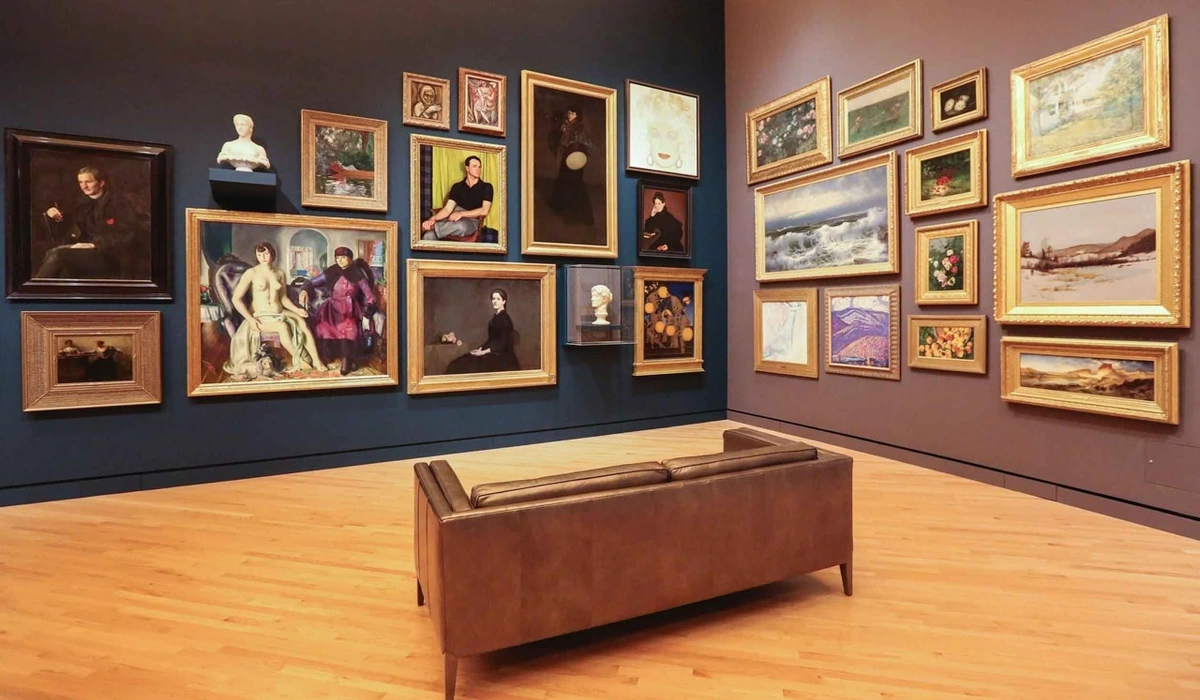
Where to Hunt for Treasures
Okay, you've got a vague idea of what you're looking for (or maybe you just know you'll know it when you see it). Where do you actually find contemporary art for your living room? Here's a quick rundown of your options. Navigating the art world can feel like a maze sometimes, but each path offers unique discoveries.
Source | Pros | Cons | Tips |
|---|---|---|---|
| Galleries | See art in person, knowledgeable staff, support local scene | Can feel intimidating, prices may be higher | Start with local art galleries, visit during openings, just browse. Like stepping into a quiet world of ideas. |
| Online Marketplaces | Huge selection, global reach, wide price range, convenient | Can't see in person, quality varies, overwhelming selection | Use filters, read reviews, check return policies, follow artists directly. (Buying Art Online: Your Guide to the Online Art Market) A vast ocean of possibilities. |
| Online Print Shops / Affordable Art Platforms | Curated selection of prints/affordable originals, often direct from artist, accessible pricing | Quality varies, less opportunity for negotiation, can still be overwhelming | Look for artist-run shops, check print quality details (paper, ink), read artist bios. Democratizing the art world, one click at a time. |
| Art Fairs | See lots of art/artists in one place, meet artists, vibrant atmosphere | Can be overwhelming, expensive, requires travel/entry fee | Plan your visit, wear comfy shoes, talk to artists, look for emerging artist sections. (Visiting Art Fairs: Your Essential (and Slightly Less Overwhelming) Guide) Prepare for sensory overload (in a good way!). |
| Artist Studios | Direct connection, see process, unique pieces, support artist directly | Requires finding/contacting artists, may need appointment | Look for open studio events (Artist Residencies & Open Studios: My Personal, Extended Guide), follow artists online. A peek behind the curtain. |
| Artist Collectives / Co-ops | Access to multiple artists, often more affordable, community feel | Varies widely in quality and professionalism, less formal structure | Look for local groups, attend their shows, connect with member artists. Strength in numbers, art in community. |
| Directly from Artist Website | Most direct support, often best price, personal connection, see full range | Requires finding the artist, less buyer protection than platforms | Follow artists on social media, sign up for newsletters, reach out directly. Cutting out the middleman, connecting with the source. |
| Online Auctions | Potential for deals, access to secondary market | Can be complex, requires research, risk of fakes/condition issues | Start with accessible platforms, set a budget, research the artist and piece carefully. (Ultimate Guide to Online Art Auctions (Beyond the Big Houses)) The thrill of the hunt. |
| Art School Shows | Discover truly emerging talent, very affordable prices | Quality varies widely, less established artists | Great for finding unique, raw pieces and supporting young artists. Raw talent, raw energy. |
| Pop-Up Exhibitions | Discover new spaces/artists, often experimental, casual atmosphere | Temporary, can be hard to find, inconsistent quality | Follow local art blogs/social media, sign up for gallery newsletters. Here today, gone tomorrow – catch it while you can! |
| Social Media | Direct access to artists, see process/studio, discover global talent | Quality varies, scams possible, less formal transaction | Follow artists you like, explore hashtags (#contemporaryart, #abstractart, #emergingartist), engage directly. Scrolling through a global gallery. |
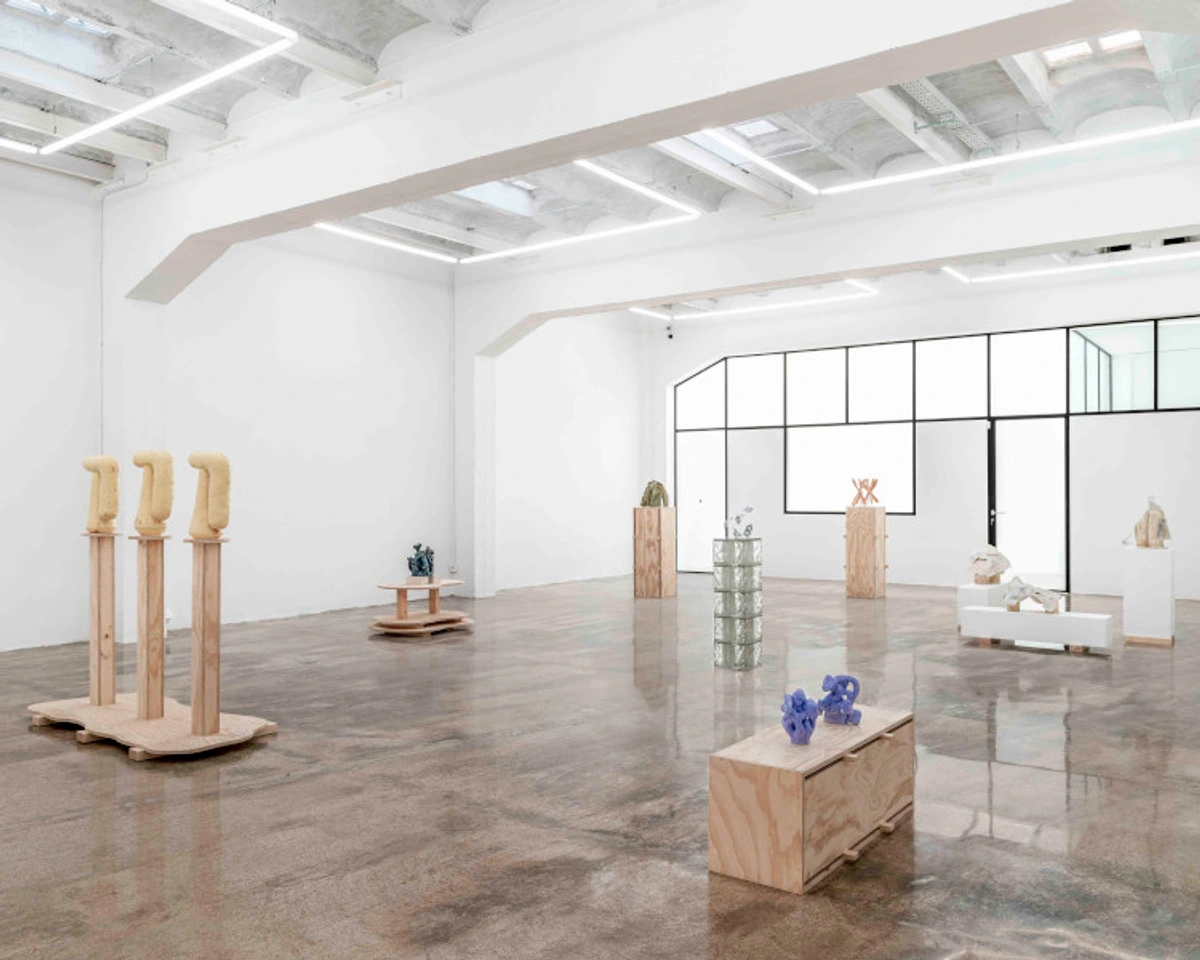
Budget & Value: It Doesn't Have to Break the Bank
Let's address the elephant in the room: cost. Contemporary art can be expensive, but it doesn't have to be. I remember my first time seriously looking at art prices and feeling like I needed a second mortgage just for a small piece! But there are options for every budget, and finding value isn't just about the price tag. It's also about the joy it brings and the connection you feel. Sometimes I see a piece with a huge price tag and think, "Wow, that's... a lot of money for that." And other times, I see a small, affordable piece that just sings to me, and I know its value to me is immense, regardless of the market. Think about the long-term value of owning something that brings you daily joy and reflection, compared to something disposable.
Originals vs. Prints
An original painting or sculpture will generally cost more than a print. But prints, especially limited edition prints, are a fantastic way to own a piece by an artist you admire at a more accessible price point. Think of it like this: an original is the unique, handwritten letter, while a limited edition print is a high-quality, numbered copy from a fixed, smaller print run, often signed by the artist. Once they sell out, no more will be made, adding to their value compared to open edition prints which can be reproduced indefinitely (like a postcard). There are also artist proofs, which are prints kept by the artist, often identical to the limited edition but marked differently, sometimes holding slightly higher value or desirability among collectors. Beyond prints, artists also create artist editions for other mediums like photography or sculpture, where a limited number of identical pieces are produced. This can make owning a sculptural work or photograph more accessible than a unique original. I've discussed the Pros & Cons of Buying Art Prints and whether Are Art Prints a Good Investment? My Personal Take. Both have their place, and a beautiful print can bring just as much joy to your living room as an original.
Emerging Artists
Buying from emerging artists is not only more affordable but also incredibly exciting. You get to support someone at the beginning of their career and potentially acquire a piece that increases in value over time (though I'd always recommend buying because you love it, not just as an investment – I've shared my thoughts on Art as an Investment: An Artist's Candid Take on Risks, Rewards & Passion). Learning How to Identify Emerging Artists Worth Collecting is a skill that comes with looking and learning. To actively find emerging artists, try following art blogs or curators who focus on new talent, explore smaller, independent galleries, or even look at online platforms specifically for emerging artists. Engaging directly with artists on social media can also give you a peek into their process and availability.
Framing Costs
Something often overlooked in the budget is framing. A good frame can significantly enhance a piece, but it can also add a substantial cost, sometimes even more than the artwork itself, especially for larger or custom sizes. Consider this when setting your budget. You might find an amazing affordable print, but if it's an unusual size, the framing could be pricey. Conversely, a slightly more expensive piece in a standard size might be cheaper overall if framing is straightforward. Different frame materials like wood or metal offer distinct aesthetics and price points. The type of glass or acrylic used also impacts cost and protection; UV protective options are more expensive but crucial for preserving the artwork from fading. Remember that matting (the border around the artwork inside the frame) not only provides visual breathing room but also helps protect the artwork by keeping it from touching the glass. I once bought a beautiful, oddly-sized print on vacation and the framing ended up costing double what the print did! Lesson learned: factor it in. For more detailed framing advice, see the "Displaying Your Art" section.
Negotiating & Payment Plans
Don't be afraid to ask about payment plans, especially for more expensive pieces. Many galleries and artists are open to spreading the cost over several months. It never hurts to ask! I've covered Negotiating Art Prices in Galleries: Your Extended Personal Guide and Negotiating Art Payment Plans: Your Guide to Making Art Dreams a Reality.
My Own Art
If you're curious about my own work, which often fits well in contemporary living spaces, you can always explore my art for sale.
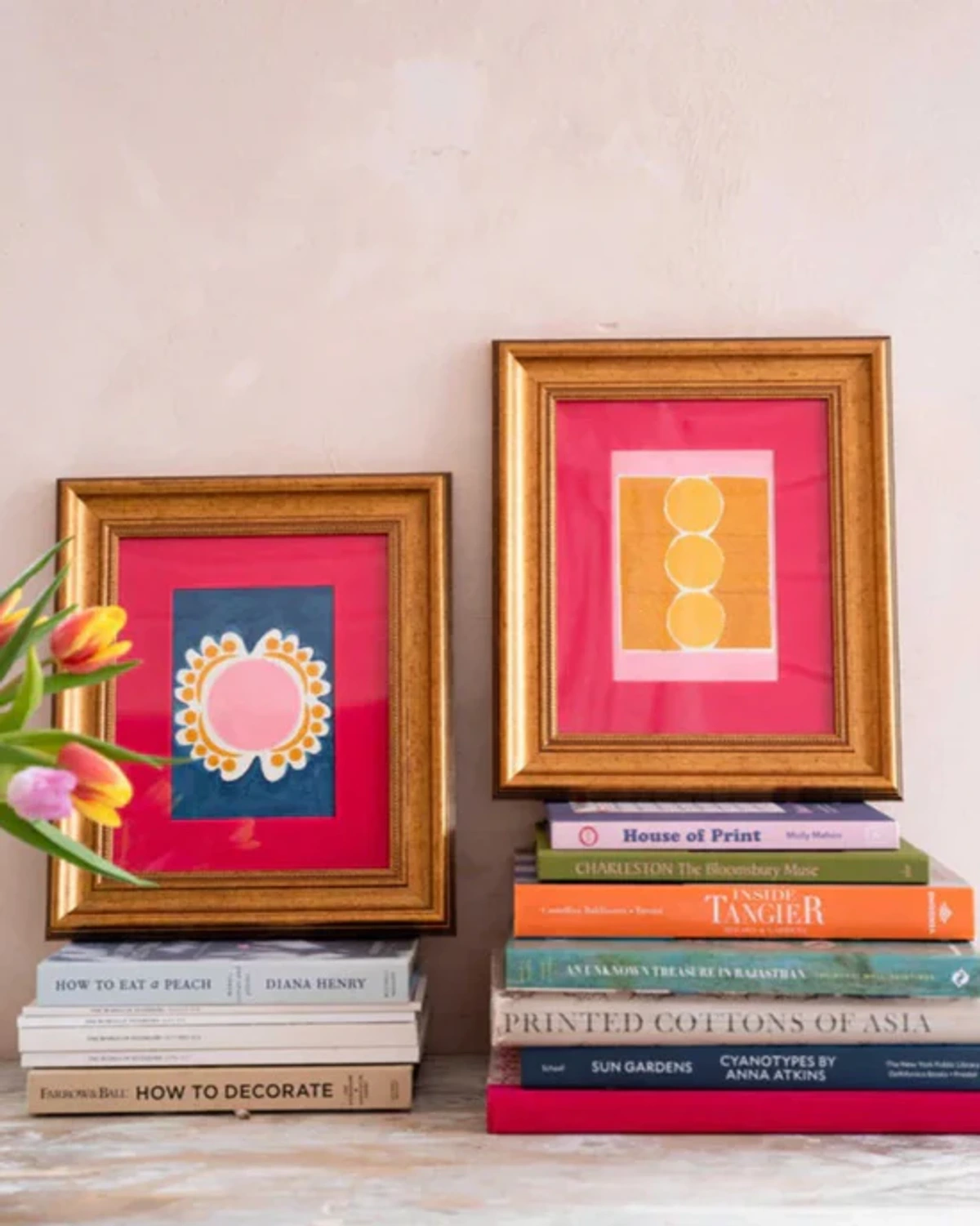
Displaying Your Art: Making It Shine
Once you've found the perfect piece (or pieces!), how do you make them look their best in your living room? Display is key! Getting the presentation right can truly make your art shine and integrate it seamlessly into your space.
Here are some tips for making your art shine:
- Placement & Hanging: Think about the focal points in your room. Above the sofa? Over the fireplace? On a large blank wall? Consider the height – generally, the center of the artwork should be at eye level (around 57-60 inches or 145-152 cm from the floor), but this can vary depending on the surrounding furniture and the height of your ceilings. If you're hanging multiple pieces, plan your gallery wall layout on the floor first. And if you're renting or just hate putting holes in walls, there are plenty of ways to hang art without nails! For larger or heavier pieces, especially sculptures or large framed works, consider hiring a professional art installer. They have the right tools and expertise to ensure your art is secure and perfectly placed. This is particularly important for valuable pieces or complex installations. I've also got guides on How to Decorate Your Living Room: Style Ideas & Layout Tips and How to Display Art at Home: Sculpture, Photography, Paintings & More.
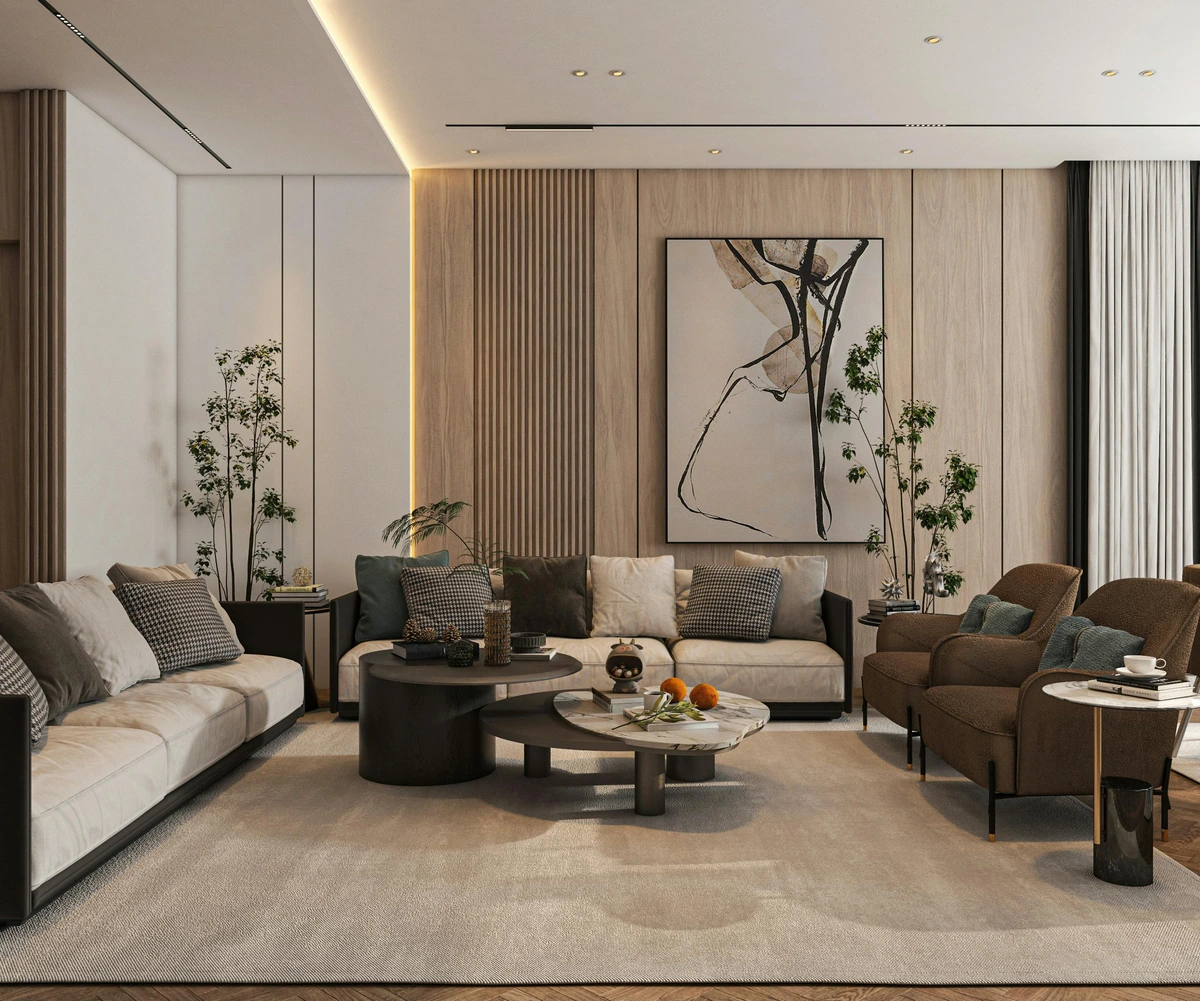
- Lighting: Good lighting can transform how art looks. Natural light is great, but avoid direct sunlight which can damage artwork over time (Protecting Your Art from Sunlight: An Artist's Guide to Preservation). Consider using specific art lighting like picture lights mounted directly on the frame, adjustable track lighting from the ceiling, or strategically placed spotlights. Picture lights offer focused illumination, track lighting provides flexibility, and spotlights can highlight specific features. Also, think about the color temperature of your bulbs – warm white (around 2700K-3000K) can enhance warm tones in art, while cooler white (3500K-4000K) or daylight (5000K-6500K) can make blues and greens pop. Visit galleries at different times of day or, if buying online, ask for photos or videos of the piece in various lighting conditions. It makes a bigger difference than you might think!
- Framing: Framing is like the outfit for your artwork – it can enhance or detract. Choose a frame that complements the piece and your room's style. Sometimes a simple frame is best, other times something more ornate works. Don't forget the matting! Matting (the border around the artwork inside the frame) gives the artwork breathing room and helps draw the eye to the piece itself, while also protecting it from touching the glass. Consider different types of glass too – UV protective glass helps prevent fading, and non-glare glass reduces reflections. Different frame materials (wood, metal, composite) and styles (minimalist, ornate, floating) can dramatically change the look and feel of a piece. For larger pieces, How to Frame Oversized Artwork: My Ultimate Personal Guide might be helpful, and my Ultimate Guide to Framing Your Artwork: Tips & Techniques covers the basics.
- Considering the Wall Color/Texture: The wall behind your art isn't just a backdrop; it's part of the display. A vibrant painting might pop against a neutral wall, while a subtle piece could get lost. Conversely, a textured wall might add an interesting dimension or compete with the artwork's own texture. Think about how the wall color interacts with the colors in the art – do they harmonize or create a dynamic contrast? This is another layer to consider in making the art feel truly integrated.
- Creative Display Ideas: Don't just think walls! Lean larger canvases against a wall for a casual, modern look. Use pedestals or plinths to display sculptures or ceramics. Integrate smaller framed pieces or objects within bookshelves or on ledges, mixing them with books and other decorative items. A beautiful print can even be displayed on an easel on the floor or a table. A mantelpiece is a classic spot to layer framed art with decorative objects, creating a curated vignette. Think outside the box! Consider hallways, kitchens, or even bathrooms (just be mindful of humidity and choose appropriate materials - see my Bathroom Art Guide: Style & Survival in Steamy Spaces!). Shadow boxes can be great for displaying objects or mixed media pieces.
- Care & Preservation: Once your art is up, a little care goes a long way. Dust gently, keep it away from extreme temperature changes and humidity (especially important for bathrooms!), and know when to call a professional if something goes wrong (When to Restore Artwork? A Personal Guide for Art Lovers & Collectors). Using acid-free materials for framing and storage is crucial for long-term preservation, preventing yellowing and degradation over time. Always handle artwork with clean hands, or wear cotton gloves, and support framed pieces by the sides of the frame, not the wire. My Art Care 101: Essential Tips to Preserve & Protect Your Artwork guide is a good starting point. Also, consider insuring more valuable pieces. It might seem excessive, but for peace of mind, knowing your cherished art is protected against damage or theft is worth it. Keeping good records of your purchases – receipts, Certificates of Authenticity (COAs), details about the artist and piece – is vital for insurance, provenance, and simply remembering the story behind each work. Caring for different mediums requires specific knowledge – for instance, cleaning acrylic paintings is different from dusting a sculpture or handling a photograph. Always research the best practices for your specific piece.

Commissioning Art: A Piece Just For You
What if you have a specific vision in mind, a particular color palette you want to match, or an awkward space that needs a custom solution? That's where commissioning art comes in. As an artist, I've had the privilege of creating pieces specifically for someone's home, and it's a truly collaborative and rewarding process.
Commissioning means working directly with an artist to create a unique piece tailored to your needs. The process usually involves discussing your ideas, the desired size, style, and color scheme, your budget, and the timeline. The artist might provide sketches or mock-ups along the way. It's a chance to get exactly what you want and build a personal connection with the creator of the art you'll live with. It can feel daunting, but many artists are happy to guide you through it. A practical way to find artists open to commissions is to look at their websites (many will have a 'Commissions' or 'Contact' section), or ask galleries that represent artists whose style you admire. I remember one commission where the client wanted a large abstract piece for a specific wall, but they had a very particular shade of blue in their sofa they wanted me to incorporate. It was a fun challenge to work within those constraints and see how the final piece transformed their space. It's an incredible way to acquire a piece that is truly one-of-a-kind and perfectly suited to your living room. You can learn more about the process in my guide on Commissioning a Custom Painting: Your Personal Step-by-Step Guide.

Building Your Collection: A Lifelong Journey
Adding art to your living room doesn't have to be a one-time event. Think of it as the beginning of a lifelong journey of building a personal collection that reflects who you are and how you evolve. It's okay to start small, perhaps with a few prints or pieces from emerging artists. Your taste will likely change over time, and that's part of the fun. Each piece you acquire can tell a story – where you found it, what it means to you, how it makes you feel. Visiting galleries, art fairs, and open studios regularly helps you discover new artists and styles. Don't feel pressured to follow trends; buy what you genuinely love. Over the years, you'll curate a space filled with pieces that hold meaning and bring you joy every day. It's about creating a living environment that grows with you. A practical step in this journey is to document your collection – take photos, note the artist, title, date, medium, dimensions, and where/when you bought it. Keep track of any Certificates of Authenticity (COAs) and receipts. This documentation is not only helpful for insurance purposes but also creates a personal archive of your art journey. Don't forget to explore local art scenes too – community events and smaller exhibitions can be fantastic places to discover hidden gems and connect with artists. If you're just starting out, check out guides like Start an Art Collection on a Budget | Affordable Tips for Beginners or Buy Art for Beginners: Your Simple Guide to Finding and Loving Art.

FAQ: Your Burning Questions Answered (Probably)
- Is contemporary art just random stuff? Ha! Sometimes it can feel that way, but usually, there's a concept, a process, or an emotion behind it. It challenges traditional ideas of what art 'should' be. It's worth trying to understand the artist's statement (Artist Statement Explained: Write Yours Without the Dread) or just letting yourself feel whatever it evokes.
- How do I know if a piece is 'good'? If you love it, it's good. Seriously. Art is subjective. Don't worry about trends or what critics say (Art Critics Today: Do They Still Matter? Evolving Impact Guide). Buy what speaks to you. (Buy Art for Beginners: Find Your Style & Start Collecting with Confidence)
- Can I mix different styles? Absolutely! An eclectic mix of styles, periods, and mediums can make a living room feel layered and interesting. Don't feel confined to one look.
- What about art for small living rooms? Art can actually make a small room feel bigger! Check out Artful Illusions: Make Your Small Room Feel Bigger With Art.
- What if I have kids or pets? How do I protect the art? Choose durable materials (canvas prints, metal prints, or framed works with acrylic instead of glass). Hang pieces securely and out of reach if necessary. For sculptures, place them on sturdy pedestals or in less accessible spots. Embrace that life happens, but take reasonable precautions! Choosing Art for Homes with Kids & Pets: Durable Art, Safe Display & Embracing Chaos has more tips.
- How do I know if the colors in the online image are accurate? This is tricky! Screen calibration varies. Reputable online galleries often provide detailed descriptions or even offer consultations. If possible, ask for more photos in different lighting or a small sample print if available. Trust your gut, but also manage expectations slightly when buying purely online.
- Should I buy a framed piece or frame it myself? It depends on your budget, the artwork, and your DIY skills. Buying framed is convenient but often more expensive. Framing yourself can save money but requires finding a good framer or having the right tools and knowledge. For valuable or delicate pieces, professional framing is usually recommended.
- How do I know if a piece is authentic? For more valuable pieces, especially originals or limited editions, ask the artist or gallery for a Certificate of Authenticity (COA). Research the artist's reputation and sales history. If buying from a gallery or auction house, they should be able to provide provenance (the history of ownership). Don't be afraid to ask questions! (Researching Artists: A Buyer's Guide on What to Know Before You Buy)
- How do I care for different art mediums? Care varies greatly! Oil and acrylic paintings need gentle dusting and stable environments. Works on paper (prints, drawings) are sensitive to light and humidity and require archival framing. Sculptures need dusting and sometimes specific cleaning based on material (bronze, wood, ceramic). Textiles need protection from pests and light. Always research the specific needs of your piece or consult a conservator. My Art Care 101: Essential Tips to Preserve & Protect Your Artwork guide touches on this, but specific research per medium is key.
- What about renting art? Art rental services can be a great way to live with art before committing to buying, or to rotate pieces regularly. It's like a library for art! It's definitely worth exploring if you're not ready to buy or want to experiment with different styles.
- How can I find artists working in a specific style I like? Once you've identified a style (like Abstract Expressionism or Pop Art), research key artists from that movement. Then, look for contemporary artists who are influenced by or work in a similar vein. Online platforms and social media are great for searching by style or keywords. Visiting galleries that specialize in certain movements can also help.
- What if I have very limited wall space? Don't despair! Consider smaller pieces, leaning art on shelves or furniture, using ledges, or even displaying art on easels. Think creatively about vertical spaces or incorporating art into existing features like bookshelves. Quality over quantity is key in small spaces.
- Should I work with an art consultant? An art consultant can be helpful if you have a significant budget, specific needs, or feel overwhelmed by the market. They can source pieces, negotiate prices, and handle logistics. However, they charge fees, and their taste might not perfectly align with yours. For many, exploring on their own is part of the joy.
- What's the difference between buying online vs. from a physical gallery? Online offers vast selection and convenience, often with lower prices, but you can't see the art in person or build a direct relationship with a gallerist. Physical galleries offer the tactile experience, expert advice, and the chance to meet artists or gallerists, but the selection is limited to their space and prices might be higher. Both are valid avenues!
- What if I buy a piece online and later decide I don't like it or it doesn't fit? Always check the return policy before buying online. Reputable platforms often have generous return windows, but some artists or smaller shops may not. Physical galleries usually have stricter return policies, often only offering exchange or store credit.
- What are the different types of framing materials and their pros/cons? Common materials include wood (classic, versatile, can be painted/stained), metal (sleek, modern, durable), and composite (affordable, lightweight, wide range of finishes). Wood can be prone to warping in humidity, metal can scratch, and composite might look less premium. The choice depends on the artwork, your style, and budget.
Conclusion: Make Your Living Room Yours
Adding contemporary art to your living room is a journey, not a destination. It's about exploring, discovering, and bringing pieces into your home that make you feel something. Don't be intimidated. Start small, trust your instincts, and choose art that you genuinely love. Your living room should be a reflection of your personality, your experiences, and your evolving taste. Let art help tell that story.
It's a process I've been on my whole life, both as an artist creating and as someone trying to make my own space feel like me. Whether you find a piece that makes you laugh, makes you think, or just makes the room feel complete, the effort is worth it. Happy hunting! What piece will you find that truly speaks to you?




